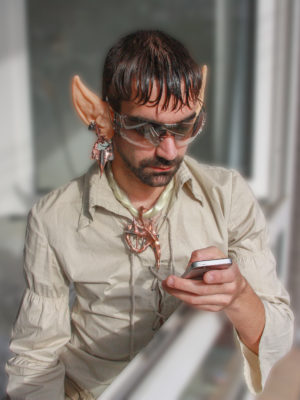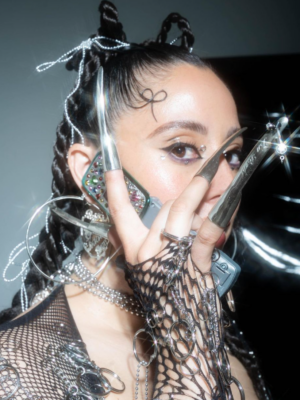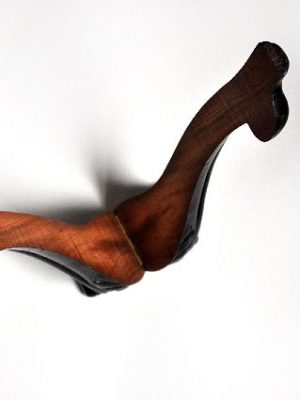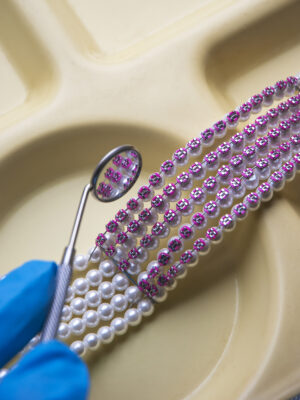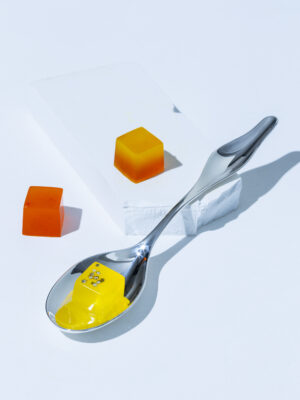Veronika Muráriková
I suppose you might be most recognised for your jewellery-based works. But interestingly, you’re doing your bachelor’s in the DesignLab at the Gerrit Rietveld Academie, not the Jewellery Department. Tell me a little bit about your background.
Simon Marsiglia
I did a foundation year of fine arts in Sweden, just to put together my portfolio and be able to apply for art schools. I’ve always wanted to go abroad to study, to be in a more international climate. That’s why I applied to the Rietveld. I was not sure regarding the direction I wanted to go in with my studies, so my idea was to aim for an education where I could implement a cross-disciplinary practice. That being said, I did not plan for that practice to include jewellery when I started my education. My background was in drawing and I had done some graphic design, but I didn’t come to the Netherlands with a jewellery background.
But you found your way to it, right? Would you
call what you are doing now jewellery?
Yeah, I think so! When I started making 3D objects like ready-mades and gadgets, it was more about creating things based on my drawings. I was looking at the work of Swedish illustrators like Ester Eriksson and Love Dahlstedt, and through them I discovered the jeweller Göran Kling, who I found out had work in the exhibition CULT at the Design Museum den Bosch [2016]. So, I went there, and that was basically my first contact with the jewellery scene. The first thing I tried immediately after seeing the show was to take the concepts I was working on at the time and try to transform them into jewellery. I realised that a lot of my sources came from subcultures that I had come across as early as my childhood, and it turned out that I was more often than not trying to recreate objects from nostalgic memories. Since everyone is nostalgic about different things, I thought that maybe nostalgia was a part of who we see ourselves to be – a stable set of memories or experiences that create my own idea of who I am. When I looked further into this, it turned out that the phrase ‘self-schema’ is a psychological term that precisely describes this idea. The self-schema refers to a long lasting and stable set of memories that summaries a person’s beliefs, experiences and generalisations about the self.
And so, I figured I could use my memories to create my own subculture. I took aspects from various fields such as hip-hop, sports, fast food, etc. Then I needed to display my new subculture. Usually a culture shows itself in abiding by a certain dress code, doing certain activities or just being interested in associated objects. I needed a character to represent my subculture and I had no intention of that character being me. Since I had already established that I was affected by these nostalgic memories, I wanted the new character to have a complete absence of existing restraints or commitments. And that’s how I found my niche.
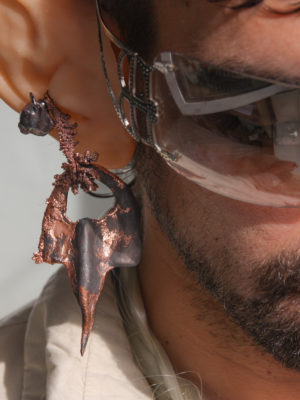
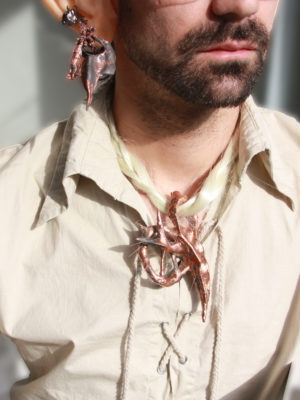
Although you’re still in school, you’ve recently managed to exhibit some of your pieces in New York at the Museum of Arts and Design. How did it feel to be part of the exhibition Non-Stick Nostalgia, surrounded by other jewellery artists and curators, so early in your career? It’s a very big accomplishment.
I felt very welcome. It was a very open environment, but to some extent, it kind of felt like I had gone from nothing to everything very quickly – from making funny things in my small student room to suddenly sitting in a museum theatre in New York, talking to an audience, being part of a full-on panel talk. Since my own work was and is revolving around how we present ourselves in a digital environment, I felt like it was a great match with the Y2K-infused theme as well as the work of the other participants. During that week last April in New York I had the opportunity to meet and be inspired by artists that I had had very little or no contact with before. To mention a few, the works of Hansel Tai and Darja Popolitova made me think about new routes to take within my own practise.
In Non-Stick, you exhibited just your digital work, the videos. Are these an essential part of your practice?
I wouldn’t say I actively strive to be a ‘digital artist’. It’s just that when you’re a part of my generation, the only common platform on which you can present yourself and display your stuff is the internet. In today’s environment, we can choose how to present ourselves online and what characteristics we want to embrace. This turns us into liquid identities that can change shape based on our own preferences and need. It really works for the alter-egos I create. Because it’s online, I’m like the ‘soul curator’ of what I’m presenting, which allows me to portray my work however I want and be whoever I want to be. A lot of the work I make has been based on characters, memories of myself, or subcultures mixed together.
Can you give us an example?
Not long ago, I can recall finding a picture of myself from when I was about eight. I’m sporting a full Wu-Tang outfit and looking really happy. I think even at that age I found everyday objects like a hoodie or a pair of sunglasses to have special powers if worn repeatedly by an idol or role model.
Your work Video Props is inspired by music. The videos are basically visualizations of different lyrics. Which songs are these from?
They’re mainly from hip-hop songs. I really enjoy the energy of hip-hop. I think in a way it relates to how I feel, especially when I’m creating something – it’s got that ‘go get it’ kind of vibe.
If somebody says in the song, for example: ‘I’ve got a fountain on my wrist’ then I can go on and create a wrist fountain. This specific sentence was a combination of two lines from Drowning by A Boogie Wit Da Hoodie. In this case, it was a very literal translation from the lyrics to the work, but there are other pieces that started as direct translations and evolved into something else.
You told me that the reason you’re creating the videos of your pieces and sharing them online is that you want to put your artwork in a broader context. Can you define what a broader context means to
you?
When you see a piece of jewellery on a white background, you’re a bit disconnected from what the
artist felt while creating it. If I have a video of me wearing the piece, moving to a song, setting a specific
atmosphere, it becomes more relatable for people. This way, I can pass on the energy I felt during the process of making it to the audience.
The other day I was listening to Sharon Berman’s Jewellery Journey podcast, with Benjamin Macklowe from Macklowe Gallery as a guest. He talked about millennials caring about the concept or story behind items of jewellery. I believe that at this moment in time, the character you are as a creator is equally as important as your work and concepts.
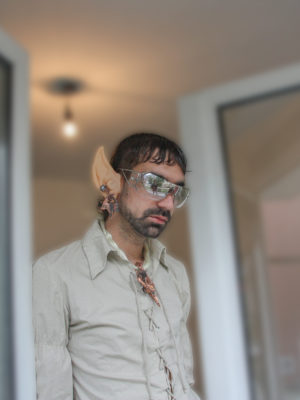
Referring back to the online environment, social media could be seen as a kind of virtual playground, a place to try out your experiments. But do you think that we tend to overshare online?
Our lives are definitely more exposed nowadays, and I feel like that puts you closer to your audience. I like it when people take part in the process, and I value the transparency as well, the constant feedback. The fact that something doesn’t need to look perfect is what that gives everything a more playful vibe. If I were to put a name to this way of working, it would be Millennial Punk. When people are like: ‘Yeah, I did this. It came out this way. Here it is. What do you think? Let’s talk about it.’ It’s a way of avoiding neat and flat presentation; it’s much more personal.
With some pieces you also create an imaginative world, with characters or a story. For example, you placed the collection Post Work Society Ornaments into a utopian world where work is forbidden, so in order to perform work, you have to camouflage working tools with ornaments.
Yes, I use the pieces I create as arguments for these imaginative worlds for the existence of their characters. Sometimes my starting point is a story, sometimes it’s based on a squiggly line drawing. Anything I can transform into a three-dimensional object is welcomed as source material.
I also think it’s good to have various starting points. I feel like having a style can be both a curse and a blessing. If you have a specific style, people expect you to keep producing in that style. On the other hand, it also provides a strong signature for you as an artist. Maybe my style could be to not have a specific style.
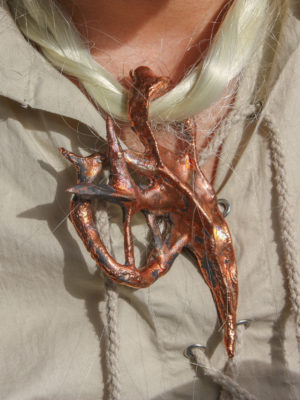
This is your graduation year. Can you reveal what are you currently working on?
I would like to go deeper into character creation and imaginative worlds. For instance, if you are a traditional jewellery artist you use a set of tools and techniques, which determine how things are done. And if someone else has this knowledge, they can somehow retrace the steps of how a piece was made. On the other hand, if someone doesn’t have that kind of knowledge, they might start to come up with an imaginary process instead. I really like the idea of a speculative scenario in which you imagine how a particular piece could have been created and for whom. That’s what intrigues me now, a hypothetical practice. It gives you an opportunity to include the process in the final work but it doesn’t limit you to what is actually true. Take the pictures attached with this interview as an example and try to imagine how the fantasy-inspired character with the Paris Hiltonesque sunglasses might go about creating the pieces that he’s wearing… see what you can make out of it!
This article is published in the OBSESSED! Jewellery Festival Paper.
OBSESSED! is a biennial jewellery festival taking place in various cities across the Netherlands. OBSESSED! unites the best jewellery-related events – museum and gallery exhibitions, talks, fairs, book presentations and artist open studios – into one intriguing programme put together by Current Obsession.
